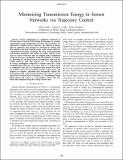Minimizing Transmission Energy in Sensor Networks via Trajectory Control
Author(s)
Ciullo, Delia; Celik, Guner Dincer; Modiano, Eytan H.
DownloadModiano-2010-Minimizing Transmission Energy in Sensor Networks via Trajectory Control.pdf (544.9Kb)
PUBLISHER_POLICY
Publisher Policy
Article is made available in accordance with the publisher's policy and may be subject to US copyright law. Please refer to the publisher's site for terms of use.
Terms of use
Metadata
Show full item recordAbstract
Energy optimization is a significant component of Wireless Sensor Network (WSN) design. In this paper we consider transmission energy optimization in WSNs where messages are collected by a mobile receiver (collector). The collector is responsible for gathering data messages by choosing the optimal path that minimizes the total transmit energy at the sensors subject to a maximum travel delay constraint. We show, both analytically and through simulation, that letting the mobile collector come closer to sensors with more data to transmit leads to significant reduction in energy consumption. Using this intuition, we propose an algorithm for choosing both the transmission radii and the mobile collector's path that achieves over 50% improvement in energy consumption compared to schemes that use a fixed communication radius for every sensor, and a 95% improvement as compared to the case of a stationary base station. We extend our results to the case of stochastic arrivals to the sensors and propose an Adaptive Algorithm that dynamically adjusts the transmission radii of the sensors based on the sensors' current queue sizes. We show that it can achieve 80% transmission energy improvement with respect to a non-adaptive scheme that uses fixed radii computed using the average arrival rates.
Date issued
2010-05Department
Massachusetts Institute of Technology. Department of Aeronautics and Astronautics; Massachusetts Institute of Technology. Department of Electrical Engineering and Computer ScienceJournal
International Symposium on Modeling and Optimization in Mobile, Ad Hoc, and Wireless Networks (WiOpt) proceedings (8th : 2010)
Publisher
Institute of Electrical and Electronics Engineers
Citation
Ciullo, Delia, Guner D. Celik, and Eytan Modiano. “Minimizing transmission energy in sensor networks via trajectory control.” Modeling and Optimization in Mobile, Ad Hoc and Wireless Networks (WiOpt), 2010 Proceedings of the 8th International Symposium on. 2010. 132-141.
Version: Final published version
ISBN
978-1-4244-7523-0